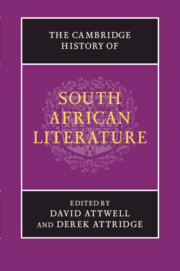Book contents
- Frontmatter
- Introduction
- PART I ORATURES, ORAL HISTORIES, ORIGINS
- PART II EXPLORATION, EARLY MODERNITY AND ENLIGHTENMENT AT THE CAPE, 1488–1820
- PART III EMPIRE, RESISTANCE AND NATIONAL BEGINNINGS, 1820–1910
- PART IV MODERNISM AND TRANSNATIONAL CULTURE, 1910–1948
- PART V APARTHEID AND ITS AFTERMATH, 1948 TO THE PRESENT
- 19 The fabulous fifties: short fiction in English
- 20 Writing in exile
- 21 Afrikaans literature, 1948–1976
- 22 Afrikaans literature after 1976: resistances and repositionings
- 23 The liberal tradition in fiction
- 24 Black Consciousness poetry: writing against apartheid
- 25 Popular forms and the United Democratic Front
- 26 Writing the prison
- 27 Theatre: regulation, resistance and recovery
- 28 The lyric poem during and after apartheid
- 29 Writing and publishing in African languages since 1948
- 30 Writing the interregnum: literature and the demise of apartheid
- 31 Rewriting the nation
- 32 Writing the city after apartheid
- PART VI SOUTH AFRICAN LITERATURE: CONTINUITIES AND CONTRASTS
- Index
- References
29 - Writing and publishing in African languages since 1948
from PART V - APARTHEID AND ITS AFTERMATH, 1948 TO THE PRESENT
Published online by Cambridge University Press: 28 January 2012
- Frontmatter
- Introduction
- PART I ORATURES, ORAL HISTORIES, ORIGINS
- PART II EXPLORATION, EARLY MODERNITY AND ENLIGHTENMENT AT THE CAPE, 1488–1820
- PART III EMPIRE, RESISTANCE AND NATIONAL BEGINNINGS, 1820–1910
- PART IV MODERNISM AND TRANSNATIONAL CULTURE, 1910–1948
- PART V APARTHEID AND ITS AFTERMATH, 1948 TO THE PRESENT
- 19 The fabulous fifties: short fiction in English
- 20 Writing in exile
- 21 Afrikaans literature, 1948–1976
- 22 Afrikaans literature after 1976: resistances and repositionings
- 23 The liberal tradition in fiction
- 24 Black Consciousness poetry: writing against apartheid
- 25 Popular forms and the United Democratic Front
- 26 Writing the prison
- 27 Theatre: regulation, resistance and recovery
- 28 The lyric poem during and after apartheid
- 29 Writing and publishing in African languages since 1948
- 30 Writing the interregnum: literature and the demise of apartheid
- 31 Rewriting the nation
- 32 Writing the city after apartheid
- PART VI SOUTH AFRICAN LITERATURE: CONTINUITIES AND CONTRASTS
- Index
- References
Summary
In his 1966 study, Neo-African Literature, Janheinz Jahn refers to ‘the tragedy of Southern Bantu literature’ (p. 100), a linguistic category that comprises nine of the country's eleven official languages: isiZulu, isiXhosa, Sesotho, Setswana, Sepedi, Tshivenda, Xitsonga, siSwati and isiNdebele. Can it be said that this ‘tragedy’ persists today? If it does, is it because the development of at least five of the literatures came about through the initiatives of missionaries who had actually come to southern Africa to spread the Gospel – an act that lured Africans away from their traditional religious roots? Did the ‘tragedy’ persist and deepen after 1948, when the National Party seized power and the literatures ran into the repressive powers of the apartheid system which held them captive for the greater part of the following five decades, both sponsoring and censoring them into insignificance? And is the ‘tragedy’ continuing in the present under the African National Congress's democratic dispensation, whose brave constitutional acknowledgement of eleven official languages, in current practice, is amounting to little more than the selection of one language of record, thereby inhibiting development in the others?
In Jahn's view, the literatures must by 1948 already have suffered from the ‘pettiness of that simple pious world’ under the missionaries. However, it was the National Party's Bantu Education Act No. 47 of 1953 ‘that swept away the mission schools and with them the sparse remains of a semi-free literature.
- Type
- Chapter
- Information
- The Cambridge History of South African Literature , pp. 607 - 632Publisher: Cambridge University PressPrint publication year: 2012
References
- 2
- Cited by

